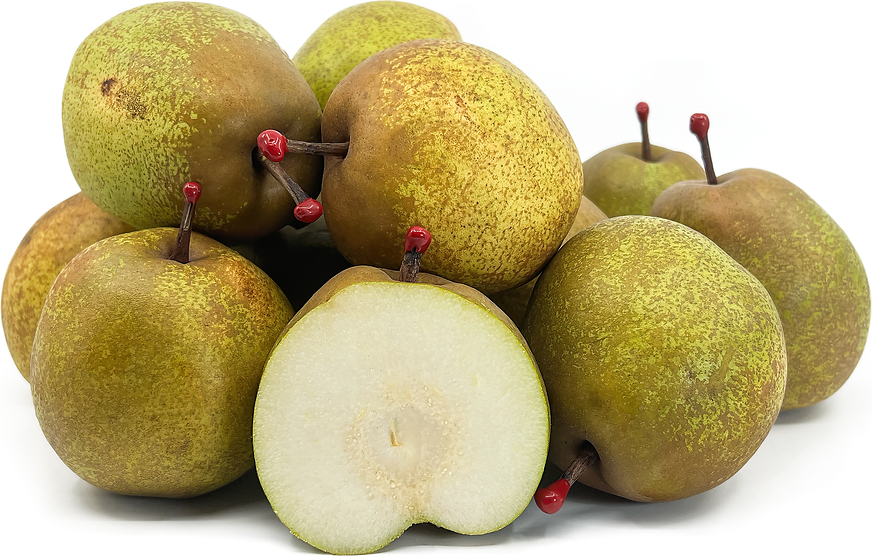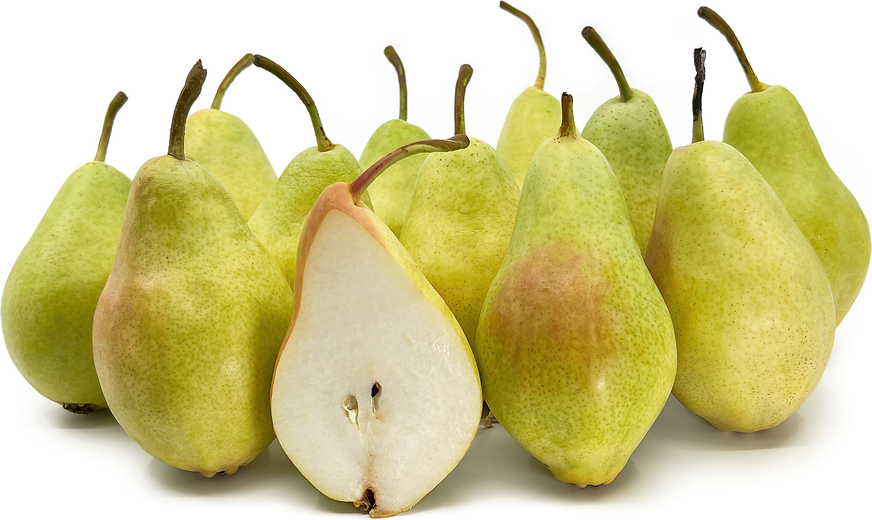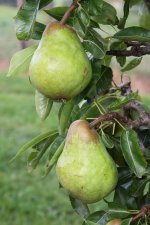You are using an out of date browser. It may not display this or other websites correctly.
You should upgrade or use an alternative browser.
You should upgrade or use an alternative browser.
Pears
- Thread starter Neno Baylov
- Start date
I adore Pears (Pyrus communis), and enjoy them much more than Apples (Malus domestica) for eating fresh. My favourite of the usually available kinds is 'Beurre Bosc'.
In the U.S., 'Williams' Pears are called 'Bartlett'.
In the U.S., 'Williams' Pears are called 'Bartlett'.
Meadowlark
No N-P-K Required
- Joined
- Feb 5, 2019
- Messages
- 2,701
- Reaction score
- 2,250
- Location
- East Texas
- Hardiness Zone
- old zone 8b/new zone 9a
- Country

Not only are they delicious eating, they are the lowest maintenance fruit of any that I grow. I have two pear trees well over 60 years of age, still heavy producers, and virtually zero maintenance...hard to beat that combination!
Very old variety from Bulgaria, the origin is unknown. The first photo shows a 150-year-old tree.
Vodnik
Vodnik blooms early. The flowers are large, white with wrinkled on
end petals and non-living pollen.Fruits regularly.From one
wood are obtained up to 500-800 kg. fruits, but only in irrigated areas with
sufficiently draining and moisture-intensive soils.
Size and weight - the fruits are well balanced in size and weight
over 200
-Form- ovoid, vice versa - ovoid or obtuse
pear-shaped, strongly swollen in the calyx third.
- Flesh-whitish with a yellowish tinge, coarse-grained, with stony
cells, very juicy, sweet, odorless, with satisfactory to good
quality.
- Consumer maturity - occurs 8-10 days after harvest, and the fruit
reach harvest maturity in late September, require some time
of storage to gain consumptive maturity.
.Disadvantages
- The meat is rough, with many stony cells, which is typical
for primitive forms
The quality of the fruit and the dried product does not satisfy
demanding consumers.



Vodnik
Vodnik blooms early. The flowers are large, white with wrinkled on
end petals and non-living pollen.Fruits regularly.From one
wood are obtained up to 500-800 kg. fruits, but only in irrigated areas with
sufficiently draining and moisture-intensive soils.
Size and weight - the fruits are well balanced in size and weight
over 200
-Form- ovoid, vice versa - ovoid or obtuse
pear-shaped, strongly swollen in the calyx third.
- Flesh-whitish with a yellowish tinge, coarse-grained, with stony
cells, very juicy, sweet, odorless, with satisfactory to good
quality.
- Consumer maturity - occurs 8-10 days after harvest, and the fruit
reach harvest maturity in late September, require some time
of storage to gain consumptive maturity.
.Disadvantages
- The meat is rough, with many stony cells, which is typical
for primitive forms
The quality of the fruit and the dried product does not satisfy
demanding consumers.
Last edited:
- Joined
- Mar 28, 2015
- Messages
- 5,063
- Reaction score
- 4,395
- Location
- Southern Chester County, PA, USA
- Hardiness Zone
- 4 to 5 best for success.
- Country

anyone have some asian pears. one of the markets carries it. awesome good.
I had Beurre Bosc, nice juicy pears, my Beurre Bosc tree died. I didn't know anything about how to grow pears then. the leaves were black.
I do not have, otherwise they are interesting, their taste is very interesting.anyone have some asian pears. one of the markets carries it. awesome good.
Some autumn photos from my pears.









Tomorrow I will take 7 more trees, I am thinking of creating my own jungle oasis.
A capricious pear grows slowly and needs a lot of care, but on the other hand one of the most delicious.
Passe Crassane Pears
Passe Crassane pears are medium to large in size and have a round to bulbous shape with a semi-thin, dark brown stem. In the marketplace, the stems are also typically sold covered in a glossy, red wax to prevent moisture loss. The smooth, thin skin is marbled with hues of green and light brown and is covered in small, prominent lenticels. Underneath the skin, the white flesh is slightly grainy, soft, and juicy with a central fibrous core running the length of the fruit containing a few seeds or being completely seedless. Passe Crassane pears are aromatic with a floral and fruity fragrance and have a crisp, melting texture with a sweet-tart flavor.
Passe Crassane pears are available in the winter through spring.
Passe Crassane pears, botanically classified as Pyrus communis ‘Passe Crassane,’ grow on small trees in temperate climates and are members of the Rosaceae or rose family. Known as a winter pear and rumored to be a cross between an unknown pear variety and a quince, Passe Crassane pears were first developed in Rouen, France around 1855 and are one of the few varieties that ripen late into the spring. Passe Crassane pears do not ripen on the tree but are harvested and stored for 6-7 months to develop a softer texture and fragrant aroma. Once popular in the 1800s and used as a parent variety for breeding new types of pears, Passe Crassane pears are somewhat rare in the present commercial market but are favored as a specialty variety for their crisp, grainy flesh, and are used in both raw and cooked culinary applications.
Passe Crassane pears contain some vitamin C, iron, and fiber.
Passe Crassane pears are best suited for both raw and cooked applications such as baking, roasting, and poaching. The fruit’s crisp but tender texture mixed with its sweet-tart flavor lends itself well to raw applications and can be served sliced, fresh out-of-hand for snacking, tossed into leafy green salads, fruit salads, or displayed on cheese plates. Passe Crassane pears can also be sliced over oatmeal such as Bircher muesli, topped on pancakes, garnished over pudding, or layered in sandwiches. In addition to fresh applications, Passe Crassane pears can be poached in wine or a winter citrus syrup, cooked into mulled wine, or baked into desserts such as almond tarts and lemon shortbread. Passe Crassane pears pair well with crème fraiche, chocolate, hazelnut, ginger, violet, lemon, walnuts, almonds, pecans, garlic, onion, smoked fish, bacon, and ham. The fruits will keep for 3-5 days at room temperature and a couple of weeks when stored in the refrigerator. This storage time may fluctuate depending on how long the individual fruit has been stored prior to reaching the market.
Passe Crassane pears were at one time one of the most popular late varieties in Italy and France and were often imported to Germany and England to be sold as luxury fruit. With the variety’s late ripening, the stems of the fruit are coated in a bright red sealing wax by hand to prevent moisture loss. This wax has become a symbol of the variety and is still used on the pears grown in France and Italy today. Though Passe Crassane pears were popular in the 1800s, they have recently declined in production due to their susceptibility to diseases such as blight. The blight outbreak affected the trees so much that in 1994, France decided to ban new plantings of Passe Crassane trees in order to help contain the disease. Today there are still some small commercial farms that cultivate Passe Crassane pears, but the variety is rare to find outside of Europe.
Passe Crassane pears were developed and planted in 1845 by Louis Boisbunel in Rouen, France, which is the capital of the region of Normandy, and the first fruits were harvested in 1855. After its introduction, the variety was grown in Italy, Spain, and France and imported to England and Germany, where it became a popular luxury fruit. In the 20th century, Passe Crassane pears largely fell out of favor due to blight and were confined to be grown in only existing orchards. Today Passe Crassane pears are still grown on a small scale in Northern Italy and Southern France and can be found at local markets in Europe. The variety is also grown in home gardens in California of the United States.





Passe Crassane Pears
Description/Taste
Passe Crassane pears are medium to large in size and have a round to bulbous shape with a semi-thin, dark brown stem. In the marketplace, the stems are also typically sold covered in a glossy, red wax to prevent moisture loss. The smooth, thin skin is marbled with hues of green and light brown and is covered in small, prominent lenticels. Underneath the skin, the white flesh is slightly grainy, soft, and juicy with a central fibrous core running the length of the fruit containing a few seeds or being completely seedless. Passe Crassane pears are aromatic with a floral and fruity fragrance and have a crisp, melting texture with a sweet-tart flavor.
Seasons/Availability
Passe Crassane pears are available in the winter through spring.
Current Facts
Passe Crassane pears, botanically classified as Pyrus communis ‘Passe Crassane,’ grow on small trees in temperate climates and are members of the Rosaceae or rose family. Known as a winter pear and rumored to be a cross between an unknown pear variety and a quince, Passe Crassane pears were first developed in Rouen, France around 1855 and are one of the few varieties that ripen late into the spring. Passe Crassane pears do not ripen on the tree but are harvested and stored for 6-7 months to develop a softer texture and fragrant aroma. Once popular in the 1800s and used as a parent variety for breeding new types of pears, Passe Crassane pears are somewhat rare in the present commercial market but are favored as a specialty variety for their crisp, grainy flesh, and are used in both raw and cooked culinary applications.
Nutritional Value
Passe Crassane pears contain some vitamin C, iron, and fiber.
Applications
Passe Crassane pears are best suited for both raw and cooked applications such as baking, roasting, and poaching. The fruit’s crisp but tender texture mixed with its sweet-tart flavor lends itself well to raw applications and can be served sliced, fresh out-of-hand for snacking, tossed into leafy green salads, fruit salads, or displayed on cheese plates. Passe Crassane pears can also be sliced over oatmeal such as Bircher muesli, topped on pancakes, garnished over pudding, or layered in sandwiches. In addition to fresh applications, Passe Crassane pears can be poached in wine or a winter citrus syrup, cooked into mulled wine, or baked into desserts such as almond tarts and lemon shortbread. Passe Crassane pears pair well with crème fraiche, chocolate, hazelnut, ginger, violet, lemon, walnuts, almonds, pecans, garlic, onion, smoked fish, bacon, and ham. The fruits will keep for 3-5 days at room temperature and a couple of weeks when stored in the refrigerator. This storage time may fluctuate depending on how long the individual fruit has been stored prior to reaching the market.
Ethnic/Cultural Info
Passe Crassane pears were at one time one of the most popular late varieties in Italy and France and were often imported to Germany and England to be sold as luxury fruit. With the variety’s late ripening, the stems of the fruit are coated in a bright red sealing wax by hand to prevent moisture loss. This wax has become a symbol of the variety and is still used on the pears grown in France and Italy today. Though Passe Crassane pears were popular in the 1800s, they have recently declined in production due to their susceptibility to diseases such as blight. The blight outbreak affected the trees so much that in 1994, France decided to ban new plantings of Passe Crassane trees in order to help contain the disease. Today there are still some small commercial farms that cultivate Passe Crassane pears, but the variety is rare to find outside of Europe.
Geography/History
Passe Crassane pears were developed and planted in 1845 by Louis Boisbunel in Rouen, France, which is the capital of the region of Normandy, and the first fruits were harvested in 1855. After its introduction, the variety was grown in Italy, Spain, and France and imported to England and Germany, where it became a popular luxury fruit. In the 20th century, Passe Crassane pears largely fell out of favor due to blight and were confined to be grown in only existing orchards. Today Passe Crassane pears are still grown on a small scale in Northern Italy and Southern France and can be found at local markets in Europe. The variety is also grown in home gardens in California of the United States.

Passe Crassane Pears
Passe Crassane pears are medium to large in size and have a round to bulbous shape with a semi-thin, dark brown stem. In the marketplace, the stems are also typically...
specialtyproduce.com
Santa Maria pears


Santa Maria pears, botanically classified as Pyrus communis, are an early-autumn variety that belongs to the Rosaceae family. The sweet fruits are native to Italy and have become a favored dessert variety throughout European and Russian markets. Santa Maria pears are commercially cultivated and grown in home gardens, valued by farmers for their sweet flavor, uniform shape, extended storage capabilities, and high yields. In Italy, the variety is often given the nickname of the “generous pear,” as the trees can produce up to 120 kilograms of large, juicy fruits. Santa Maria pears are primarily consumed fresh, but the fruits can also be used in a wide variety of juices, baked goods, and condiments.

Santa Maria Pears
Santa Maria pears are large, uniform fruits, averaging 4 to 6 centimeters in diameter and 6 to 8 centimeters in length, and have an elongated, oval to pyriform...
specialtyproduce.com
I planted five pears (trees), Santa Maria, Carmen, Beurre Hardy. My wild garden wouldn't be so nice, my helpers (chickens).
Last edited:
Ask a Question
Want to reply to this thread or ask your own question?
You'll need to choose a username for the site, which only take a couple of moments. After that, you can post your question and our members will help you out.
Similar Threads
Forum statistics
Latest Threads
-
Preparing flower beds?
- Started by JMBrowning
-
Must have been mislabeled
- Started by Texas001
-
Selling sites for carnivorous plants
- Started by texc16195
-
Knock Out Roses Changing Colors
- Started by Harveyshot
-
Mushrooms
- Started by big rockpile
-
Herb Bed
- Started by big rockpile
-
Go All The Way
- Started by big rockpile
-
Im being attacked left, right, and center!
- Started by JittyJohnser
-
If This Passes What Are The Farmers Going To Do?
- Started by big rockpile
-
How to overwinter mint in pot
- Started by texc16195


